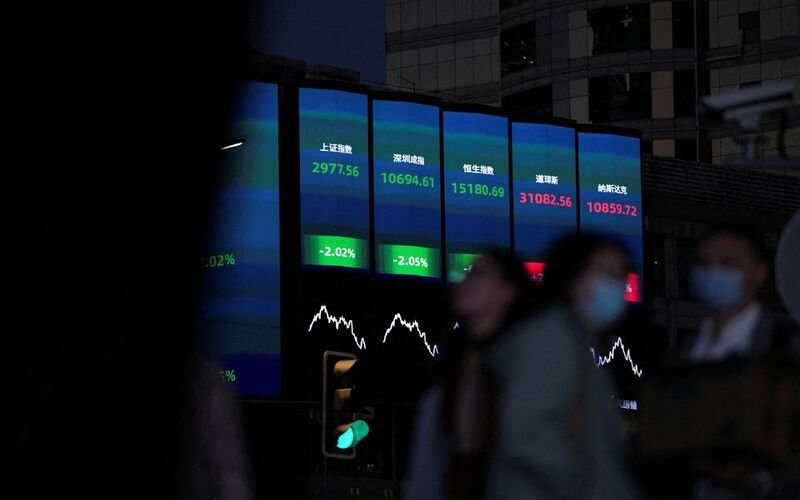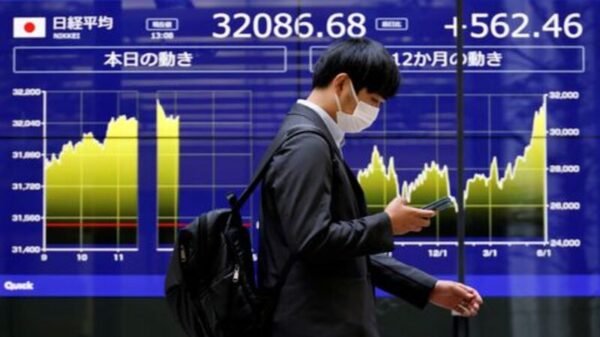Stocks struggle as oil surge sets the stage for hawkish Fed. The 10-year U.S. Treasury yield hit a 16-year high on Wednesday, but Asian markets struggled to gain ground. Rising oil prices are fueling inflation and creating the conditions for the Federal Reserve to project interest rates will remain higher for longer.
Despite overnight losses from 10-month highs, Brent oil futures are up 30% in three months at $94.26 per barrel thanks to Saudi Arabia and Russia’s pledge to continue their supply curbs.
According to overnight statistics, higher energy prices caused a larger-than-anticipated increase in Canadian inflation, which boosted the loonie and sparked selling in the Treasury market.
Benchmark 10-year Treasury yields overnight reached 4.371%, their highest level since 2007, and ended the day at 4.36%.
Japan’s Nikkei (.N225) and MSCI’s broadest index of Asia-Pacific equities outside Japan (.MIAPJ0000PUS) decreased by 0.2%. The S&P 500 (.SPX) decreased 0.2% overnight on Wall Street.
Although traders have started pulling back bets on cuts in 2024, they will intently watch the U.S. central bank’s economic estimates and Chairman Jerome Powell’s news conference. Futures pricing implies essentially no likelihood of a Fed hike at 1800 GMT.
Many participants in the prior dot plot anticipated a cut in 2024. According to Sam Rines, managing director of the Texas-based research firm CORB, there is no reason for those dots to move noticeably.
The Powell presser’s “risk management” component “is likely to be positive with respect to downward adjustments to the policy rate as or if inflation wanes, (but) negative with respect to threats of future tightening,” according to the report.
The Fed meeting kicks off a week filled with data and meetings from other central banks over the following few days. British inflation data are due on Wednesday, following Thursday’s central bank meetings in Sweden, Switzerland, Norway, Britain, and Japan.
STEADY STERLING Ahead of CPI
Although the yen has continued to come under pressure, the foreign exchange markets have mainly been in a holding pattern ahead of the Fed meeting, which prompted a retort from Japan’s top financial ambassador early on Wednesday.
Masato Kanda told reporters that Japanese and American colleagues were constantly in close contact and that he wouldn’t rule out any actions should “excessive moves persist.”
As expectations grow that U.S. rates will remain high and Japanese rates will remain low, the yen has fallen 11% against the dollar this year. Late last week, the yen reached a 10-month low against the dollar at 147.95, and early on Wednesday, it traded at 147.80.
Japanese benchmark 10-year government bond yields are still capped at 0%, but at 0.72%, they are edging closer to the Bank of Japan’s revised tolerance for yields of 1% on each zero side.
The euro stayed at $1.0684 throughout. The currencies of commodity exporters remained strong, with the New Zealand dollar retaining moderate recent gains at $0.5940 following significant increases in dairy prices at an overnight auction.
As anticipated, China maintained its benchmark lending rates unchanged on Wednesday, holding the yuan constant at 7.2946 to the dollar.
Ahead of British inflation data due at 0600 GMT, where headline CPI is expected to increase to 7% year-over-year, the Australian dollar stayed at $0.6415, while sterling halted its decline and held at $1.2390.
Strong outcomes are possible, according to Commonwealth Bank of Australia strategist Kristina Clifton, given the robust growth in labor earnings.
The financial markets may fully price a 25 basis point increase for the Bank of England on Thursday due to a higher CPI figure, which would help sterling.
With spot gold last trading at $1,929 per ounce, rising rates have held gold prices in check.
Due to hopes that dry weather will reduce production in Australia and Argentina, wheat prices, which had previously been depressed by massive supplies from Russia, have stabilized.

















































Comment Template